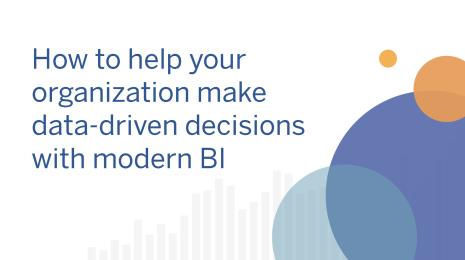Value series: Change user behaviors with agile analytics to drive transformation
Editor’s note: This is the second post in our series about modern analytics for enterprise transformation. Please read the first about evaluating technology for transformational potential.
Realizing the value of data for digital transformation, many organizations today are increasing their modern analytics investments to innovate and accelerate change, including identifying cost savings and finding new revenue streams. Everyone agrees that putting data at the center of conversations can drive change. However, most organizations are failing to successfully implement an enterprise-wide analytics program. Where do they go wrong?
IT is tasked with giving people the relevant data they need for decision-making, but beyond access to the data, everyone needs the motivation and confidence to properly make decisions with it. Data-driven transformation requires IT leaders be agile—not only deploying a technical solution, but iterative change management that creates real business value and enables new behaviors in their people. This requires putting tools and processes in place that people will actually use, teaching them new skills, encouraging new patterns, and recognizing achievements.
Let’s look at some of the barriers organizations face along the way, and how you can think differently about an agile deployment strategy that enables transformative change.
Working from the ground up to grow the program
Smaller, departmental implementations are commonly a starting point to test use cases before an enterprise-wide analytics deployment. You may utilize this approach if you need to first demonstrate the value and ROI of a modern, self-service approach. One of the greatest challenges with this route is getting executive sponsorship.
Power users often serve as champions for these kinds of projects, but executive sponsorship is necessary to scale analytics across the enterprise. Executive leadership helps to align the organization’s vision for using data, focus efforts to grow the analytics program, and set behavioral examples for the organization. Top-down motions to put data at the center of operations may help end the era of “I’ll get back to you after I crunch the numbers,” allowing for productive, data-driven conversations in meetings.
Additionally, it’s critical to measure and prove the impact of your efforts in deploying and growing your analytics program. This means understanding which metrics best capture the cumulative impact of your iterative deployments, governance practices, increasing analytical skill sets, and community growth. Suitable metrics—especially for measuring behavioral changes—will vary for each organization, and should be evaluated at regular intervals as analytics practices evolve.
Fighting perception battles related to governance
Perhaps the most important principle when adopting modern analytics is that self-service and governance are not at odds with each other. Self-service is designed to enable everyone to ask and answer their own questions using trusted data to make informed business decisions, not just explore dashboards created by analysts. In a self-service environment with true governance, system administrators don't fear free-form exploration of data—in fact they encourage it, because it allows them to better monitor the system and provision the right data. Simply put, governance makes self-service possible.
With too much control, IT may stifle the use cases the analytics environment can support, potentially blocking innovation that results from users discovering new data sources or new applications of data. Over-governing your analytics environment can create the perception that it isn’t helpful—people log in to the system and can’t find data that’s relevant to them. They may take data to spreadsheets to try to answer their questions outside the governed environment, and end up risking data security.
On the other hand, if the environment is too loosely governed and managed, users may find themselves lost in too much content, or interacting with data in a way that puts unnecessary load on the system. Without standards for how content is created and optimized, people can experience frustrations with performance and may feel that the system is too slow, too disorganized, or just doesn’t work.
Delegating responsibilities with growth
Modern analytics shifts IT’s role to a more strategic partner for the business, empowering users to navigate a trusted, self-service environment. At scale, this also requires IT to delegate some of the responsibilities of a traditional, top-down BI approach. With the right processes, standards, and training, business users can help manage data sources, analytics content, and users in the system, as well as contribute to education, evangelism, and the internal community. When users value and participate in these efforts, IT can manage strategic initiatives like business SLAs and ensuring the security of company assets.
This is a huge step in realizing your organization’s vision for self-service analytics. If you’re transitioning from a traditional approach driven by IT, or bridging a skills gap, it’s a good idea for a centralized BI team to build out the initial use cases across departments, like IT or a data steward building trusted data sources and people with analytical training building dashboards. Then, as people learn the necessary skills, IT can delegate responsibilities.
Empowering people to learn and share
Would most of your business users today know where to find the data they need? Do they understand table structures and data relationships in your modern data architecture? They may have data that answers one question, but need to combine it with other data to answer additional questions. How do you encourage proficiency for everyone at the appropriate levels?
Start by taking stock of what skills exist and what are needed. Look at the types of people who currently participate in analytics, where they are and where they need to be with their abilities. Define learning personas to classify different types of users by mapping organizational roles and their relationships to data. Then match them to the corresponding learning path to support the skills they need.
Another key element in getting people engaged with using data is to build community. When people connect with one another to share ideas and celebrate successes, it reinforces the values and behaviors data-driven decision-making and can inspire innovations. It also makes learning and participating in analytics more fun, satisfying the innate human curiosity and creativity that can make important work feel less repetitive and more fulfilling. Consider gamification and friendly competitions to encourage creativity, fun, and community.
Staying agile and adaptable
An agile approach means creating a feedback loop of evaluation and improvement. You should proactively reassess needs—from your server topology and user licensing to the analytics use cases and processes that support them. Business doesn’t slow down, and your analytics program should be adaptable to address evolving requirements. Close communication with line of business leaders will help keep everyone aligned to drive targeted improvements as you refine and expand your analytics strategy and deployment.
Monitoring and maintenance are key responsibilities to enable agility and keep pace with increased workloads of more users, new data, and new use cases. This also helps you to identify and fix problems with performance in your environment, and provide opportunities to further educate the business on analytics best practices. Depending on the size of your organization and deployment, monitoring and measurement responsibilities may be split across different teams to more effectively track utilization and performance.
Investing in a thorough data strategy before deployment
Agile deployment starts with discovery and planning. The better you understand your organization’s requirements, the better you will be able to proactively support the broad use of data. Growing your modern analytics deployment to drive enterprise-wide change relies on a systematic, repeatable approach to identify key sources of data, how data is selected, managed, distributed, consumed, and secured, and how users are educated and engaged.
Although every organization’s journey to building a data-driven organization will differ, achieving your transformational goals requires a deliberate and holistic approach to developing your analytics practice. If you’re hitting the roadblocks we discussed, make sure your agile deployment strategy covers more than just the technology.
Want to learn more? Please join our webinar series on generating value with analytics. We’re excited to welcome our customer Dropbox, partner Slalom, and market research analyst Forrester—we hope to have you with us!
Read the next post in our series to learn why it's time to reevaluate how you measure the value of analytics.
関連ストーリー
Subscribe to our blog
Tableau の最新情報をメールでお知らせします









